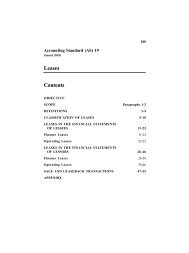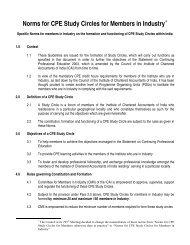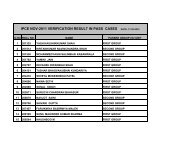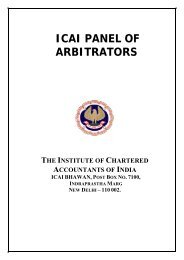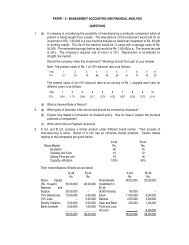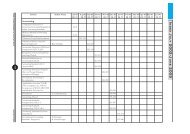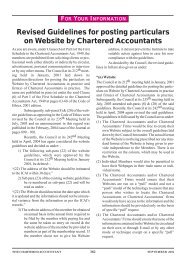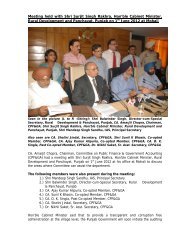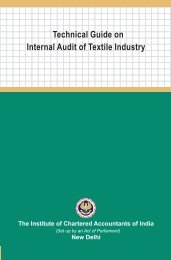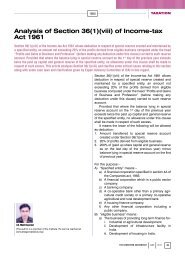The Chartered Accountant
The Chartered Accountant
The Chartered Accountant
Create successful ePaper yourself
Turn your PDF publications into a flip-book with our unique Google optimized e-Paper software.
cial statements (in other cases<br />
those charged with governance<br />
have this responsibility).<br />
Requirements<br />
Those Charged with Governance<br />
7. <strong>The</strong> auditor shall determine the<br />
appropriate person(s) within the entity’s<br />
governance structure with whom<br />
to communicate. (Ref: Para. A5-A8)<br />
Communication with a Subgroup<br />
of Those Charged with Governance<br />
8. When the auditor communicates<br />
with a subgroup of those charged<br />
with governance, for example, an audit<br />
committee, or an individual, the<br />
auditor shall determine whether the<br />
auditor also needs to communicate<br />
with the governing body. (Ref: Para.<br />
A9-A11)<br />
When All of Those Charged with<br />
Governance are Involved in Managing<br />
the Entity<br />
9. In some cases, all of those<br />
charged with governance are involved<br />
in managing the entity, for example, a<br />
small business where a single owner<br />
manages the entity and no one else has<br />
a governance role. In these cases, if<br />
matters required by this SA are communicated<br />
with person(s) with management<br />
responsibilities, and those<br />
person(s) also have governance responsibilities,<br />
the matters need not be<br />
communicated again with those same<br />
person(s) in their governance role.<br />
<strong>The</strong>se matters are noted in paragraph<br />
12(c). <strong>The</strong> auditor shall nonetheless<br />
be satisfied that communication with<br />
person(s) with management responsibilities<br />
adequately informs all of those<br />
with whom the auditor would other-<br />
DECEMBER 2008 1092 THE CHARTERED ACCOUNTANT<br />
STANDARDS<br />
wise communicate in their governance<br />
capacity. (Ref: Para. A12)<br />
Matters to be Communicated<br />
<strong>The</strong> Auditor’s Responsibilities in<br />
Relation to the Financial Statement<br />
Audit<br />
10. <strong>The</strong> auditor shall communicate<br />
with those charged with governance<br />
the responsibilities of the auditor in<br />
relation to the financial statement audit,<br />
including that:<br />
(a) <strong>The</strong> auditor is responsible for<br />
forming and expressing an<br />
opinion on the financial statements<br />
that have been prepared<br />
by management with the oversight<br />
of those charged with<br />
governance; and<br />
(b) <strong>The</strong> audit of the financial statements<br />
does not relieve management<br />
or those charged with<br />
governance of their responsibilities.<br />
(Ref: Para. A13-A14)<br />
Planned Scope and Timing of the<br />
Audit<br />
11. <strong>The</strong> auditor shall communicate<br />
with those charged with governance<br />
an overview of the planned scope and<br />
timing of the audit. (Ref: Para. A15-<br />
A19)<br />
Significant Findings from the Audit<br />
12. <strong>The</strong> auditor shall communicate<br />
with those charged with governance:<br />
(Ref: Para. A20)<br />
(a) <strong>The</strong> auditor’s views about significant<br />
qualitative aspects of<br />
the entity’s accounting practices,<br />
including accounting policies,<br />
accounting estimates and<br />
financial statement disclosures.<br />
When applicable, the auditor<br />
shall explain to those charged<br />
with governance why the auditor<br />
considers a significant<br />
accounting practice, that is acceptable<br />
under the applicable<br />
financial reporting framework 5 ,<br />
not to be most appropriate to<br />
the particular circumstances of<br />
the entity; (Ref: Para. A21)<br />
(b) Significant difficulties, if any,<br />
encountered during the audit;<br />
(Ref: Para. A22)<br />
(c) Unless all of those charged<br />
with governance are involved in<br />
managing the entity:<br />
(i) Material weaknesses, if any,<br />
in the design, implementation<br />
or operating effectiveness<br />
of internal control that<br />
have come to the auditor’s<br />
attention and have been<br />
communicated to management<br />
as required by SA<br />
315 6 or SA 330 7 ;<br />
(ii) Significant matters, if any,<br />
arising from the audit that<br />
were discussed, or subject<br />
to correspondence with<br />
management; and (Ref:<br />
Para. A23)<br />
(iii) Written representations the<br />
auditor is requesting; and<br />
(d) Other matters, if any, arising<br />
from the audit that, in the auditor’s<br />
professional judgment, are<br />
significant to the oversight of<br />
the financial reporting process.<br />
(Ref: Para. A24)<br />
5Revised ISA 200, “Overall Objectives of the Independent Auditor and the Conduct of an Audit in accordance with International Standards on Auditing”, Paragraph 13(a)<br />
defines the applicable financial reporting framework as “<strong>The</strong> financial reporting framework adopted by management and, where appropriate, those charged with governance<br />
in the preparation and presentation of the financial statements that is acceptable in view of the nature of the entity and the objective of the financial statements, or that is<br />
required by law or regulation. <strong>The</strong> term “fair presentation framework” is used to refer to a financial reporting framework that requires compliance with the requirements of<br />
the framework and:<br />
(i) Acknowledges explicitly or implicitly that, to achieve fair presentation of the financial statements, it may be necessary for management to provide disclosures beyond those<br />
specifically required by the framework; or<br />
(ii) Acknowledges explicitly that it may be necessary for management to depart from a requirement of the framework to achieve fair presentation of the financial statements.<br />
Such departures are expected to be necessary only in extremely rare circumstances.<br />
<strong>The</strong> term “compliance framework” is used to refer to a financial reporting framework that requires compliance with the requirements of the framework, but does not contain<br />
the acknowledgements in (i) or (ii) above”.<br />
6SA 315, “Identifying and Assessing the Risks of Material Misstatement Through Understanding the Entity and Its Environment”, paragraph 32. SA 315 is published in the<br />
February, 2008 issue of the Journal.<br />
7SA 330, “<strong>The</strong> Auditor’s Responses to Assessed Risks”, paragraph 19. SA 330 is published in the February, 2008 issue of the Journal.



